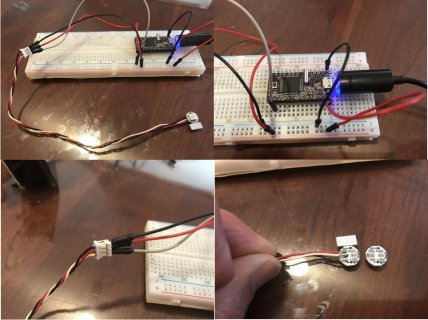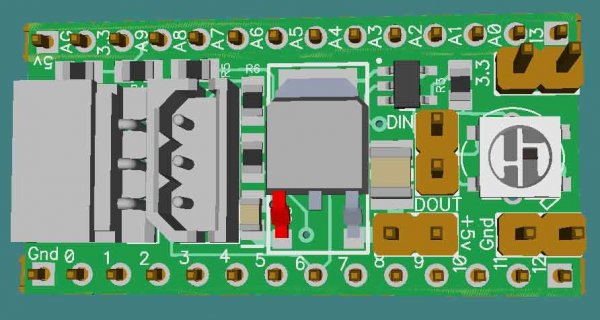Axiom Greg
Active member
Hello,
I just started playing around with neopixels. I thought I'd start by trying to light a single neopixel with a Teensy 3.1 which seems like it should be pretty easy to do. However, no success thus far. I am using the Adafruit Neopixel library. I have connected the Neopixel to power, ground and data (the latter being a DO on the Teensy). I am using a 500ohm current limiting resistor on the DO. In all cases, the Teensy is being powered by USB. Here's what I've tried so far:
1) Power the neopixel with Vin (5v) from the Teensy usb.
2) Power the neopixel with V3.3 from the Teensy.
3) Same as 1, but powering the neopixel with a diode in series with the 5V (the idea is to drop the voltage a bit).
4) Try 1 and 2 without the current limiting resistor (hopefully I didn't damage the neopixel, but have I have several of them which I can try for testing purposes).
(at most, I have seen the neopixel briefly flash on power up. I believe that was case 4 above).
I have been assuming that my issue has to do with level shifting, but I'm not 100% sure. I see that there is the OctoWS2811 Adaptor, but that is way overkill for my project since I only need to power 8 neopixels.
Since all of my experimentation hasn't worked, what I would like to know is if there is a recommended way to drive a small number of neopixels from the Teensy (apparently I haven't found it).
Thank you!
I just started playing around with neopixels. I thought I'd start by trying to light a single neopixel with a Teensy 3.1 which seems like it should be pretty easy to do. However, no success thus far. I am using the Adafruit Neopixel library. I have connected the Neopixel to power, ground and data (the latter being a DO on the Teensy). I am using a 500ohm current limiting resistor on the DO. In all cases, the Teensy is being powered by USB. Here's what I've tried so far:
1) Power the neopixel with Vin (5v) from the Teensy usb.
2) Power the neopixel with V3.3 from the Teensy.
3) Same as 1, but powering the neopixel with a diode in series with the 5V (the idea is to drop the voltage a bit).
4) Try 1 and 2 without the current limiting resistor (hopefully I didn't damage the neopixel, but have I have several of them which I can try for testing purposes).
(at most, I have seen the neopixel briefly flash on power up. I believe that was case 4 above).
I have been assuming that my issue has to do with level shifting, but I'm not 100% sure. I see that there is the OctoWS2811 Adaptor, but that is way overkill for my project since I only need to power 8 neopixels.
Since all of my experimentation hasn't worked, what I would like to know is if there is a recommended way to drive a small number of neopixels from the Teensy (apparently I haven't found it).
Thank you!
Code:
#include <Adafruit_NeoPixel.h>
//create a NeoPixel strip
Adafruit_NeoPixel strip = Adafruit_NeoPixel(1, 14, NEO_GRB + NEO_KHZ800);
void setup() {
Serial.begin(9600);
strip.setBrightness(30);
strip.show();
delay(100);
}
// The main program
void loop() {
strip.setPixelColor(0, 0, 255, 0);
strip.show();
}
Last edited:




